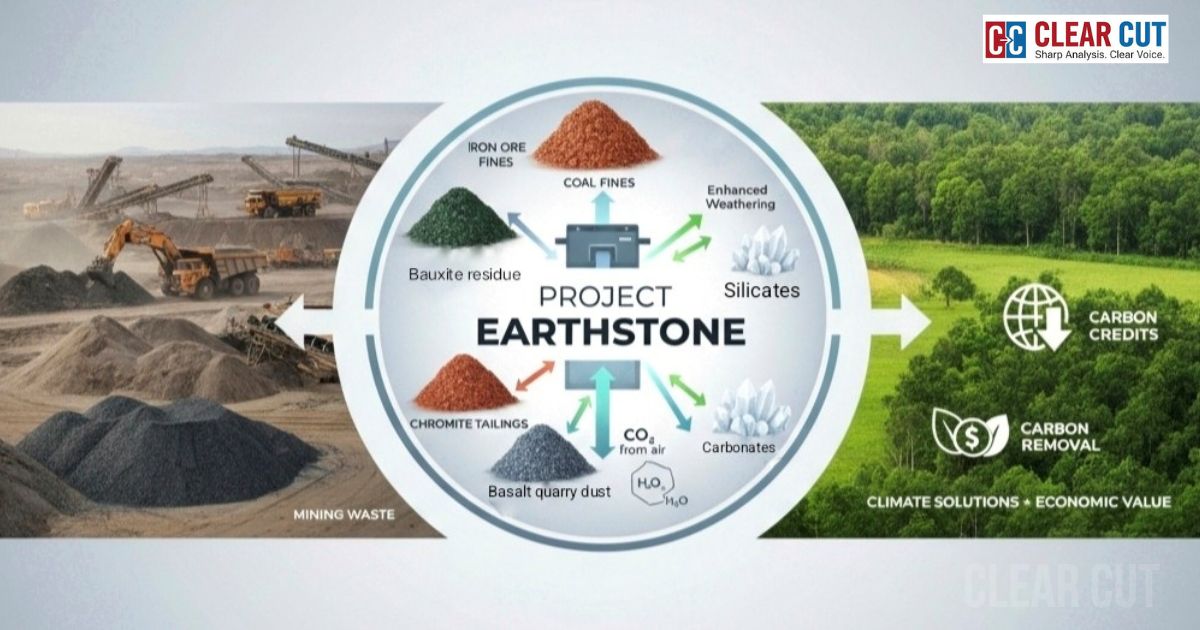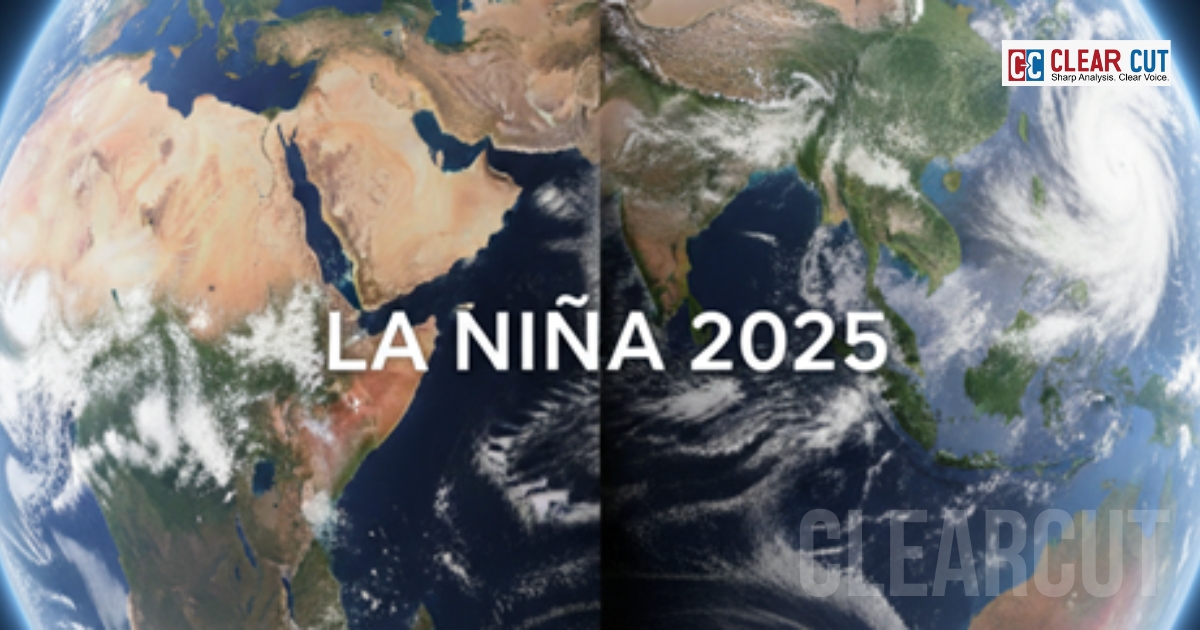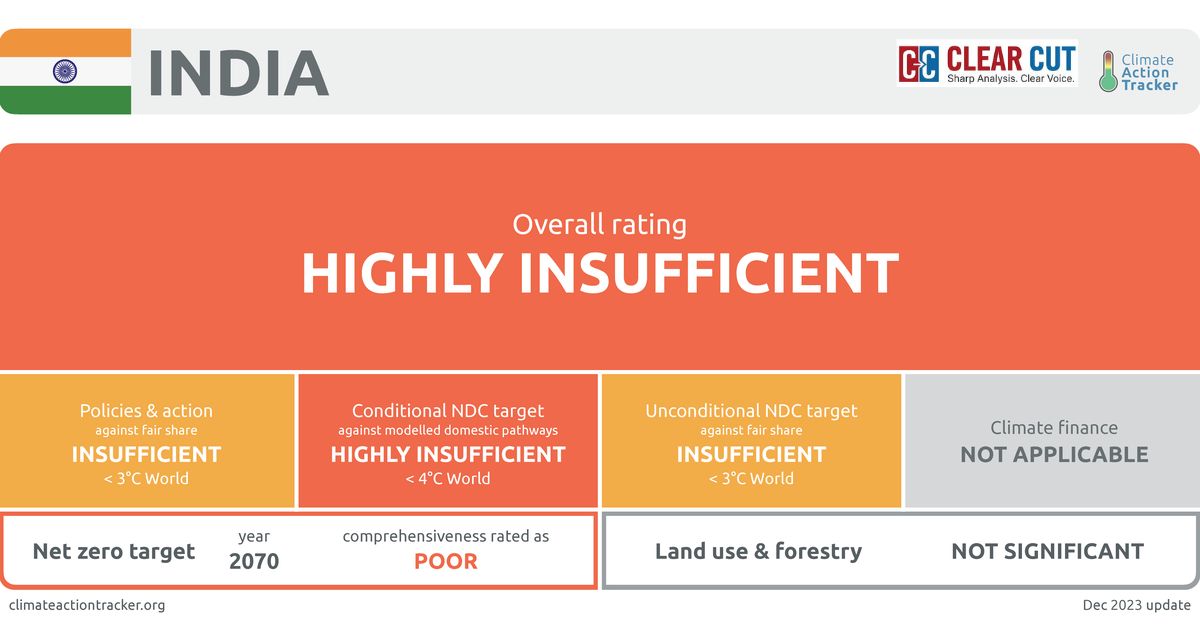Photo Credit: Antara Mrinal
Clear Cut Climate Desk
New Delhi, UPDATED: Oct 06, 2025 04:04 IST
Written By: Antara Mrinal
The Genesis of Project Earthstone
On September 23rd 2025, Project Earthstone was launched in Brazil, bringing together three global leaders: Isometric (a carbon removal standards and registry organization), Anglo American (the largest producer of platinum in the world and a mining company), and ZeroEx (Germany-based Enhanced Weathering expert). This collaboration seeks to reform the mining industry by converting mining by-products into large volumes of carbon storehouses, which is an important and productive step toward climate technology and environmental sustainability in mining technology.
The concept is simple but novel; mining creates massive quantities of by-products and material, rarely regarded as anything more than waste. However, many of these materials have naturally occurring carbon-capturing properties because they are composed of silicate minerals. If these materials are reduced in size into a fine powder and then exposed to air and water, or “Enhanced Weathering” (EW), a natural chemical process takes place and locks CO₂ into stable minerals. Project Earthstone aims to prove that scaling Enhanced Weathering as a carbon removal process is possible and safe, that it can be verified, and that it is economically viable on the gigatonne scale.
Mining By-products: From Wastes to Carbon Storehouses
Mining creates massive waste streams: iron ore fines, coal rejects, bauxite residue (red mud), chromite tailings, and more. These have traditionally been viewed as environmental liabilities, but under the EW framework, they can become a valuable asset.
So long as they contain silicate minerals like basalt, olivine, and serpentine (among others), when they weather and break down, they can subsequently chemically bind with CO₂. Existing mining by-products are already mined and partially processed, which will translate into cost savings for utilities (the existing products already have transportation and processing costs considered), all waiting to be extracted, which is the low-hanging fruit for climate programs. This reuse is also a way to solve disposal issues, transforming a waste stream from burden to climate solution. Project Earthstone is one of the first large-scale efforts to systematically capitalize on these materials for verified carbon removal credits.
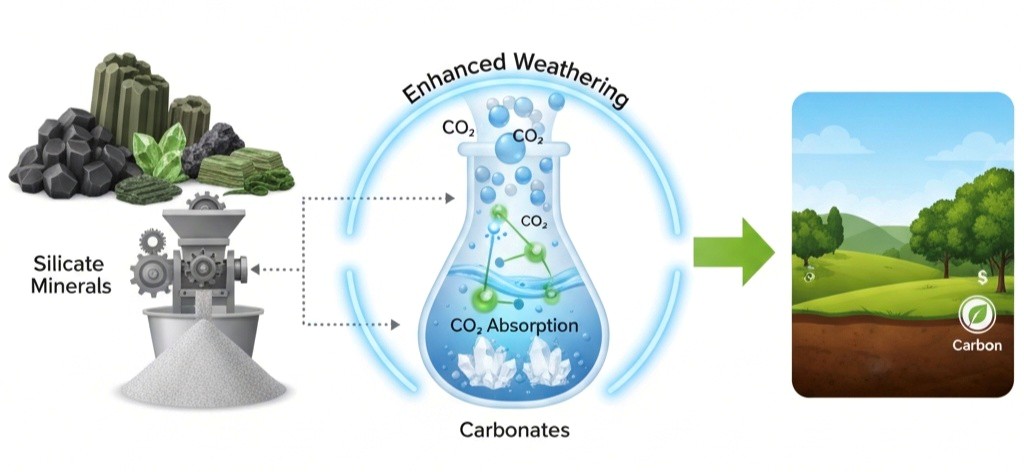
Enhanced Weathering Explained
Enhanced Weathering (EW) is a method that speeds up a natural process that has moderated Earth’s climate for millions of years. Silicate rocks break down in the presence of meteoric and atmospheric CO₂ into geologically-stable carbonates that lock up carbon for geological timescales. If finely crushed silicate material is dispersed over land or within coastal environments, this component of the natural carbon sink can be accelerated at a remarkably higher rate.
Scientific literature estimates that, if implemented at quantity, EW could sequester 2-4 gigatonnes of CO₂ annually all by mid-century. The hardest part is verifying if it works, reliably, safely, and economically. Project Earthstone in Brazil is designed to demonstrate feasibility at the megatonne level, with third-party verification through Isometric’s registration.
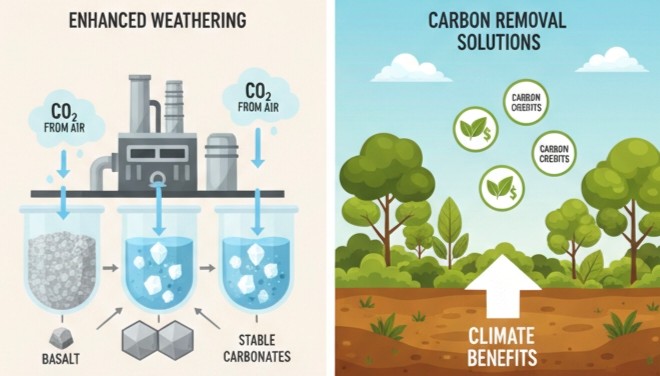
Can India be the Next Frontier for Enhanced Weathering
With its massive mining sector, silicate-rich by-products, and urgent climate obligations, India has a desirable opportunity to replicate Project Earthstone. India has also already established the Indian Carbon Market (ICM) under the Energy Conservation Act, 2022, to develop a market and provide carbon credits. India is well positioned to test EW-based carbon removal projects in mining.
There is tremendous potential feedstock: India is the second largest producer of coal, a key player in iron ore and bauxite, and hosts the Deccan Traps basalt province, one of the world’s largest silicate reserves.
India’s Mining Giants and Carbon Removal Potential
To illustrate the opportunity, here is a table of India’s leading mining companies, their key commodities, and the estimated scale of by-products that could serve as carbon storehouses.
Table: India’s Mining Giants and Potential By-products for Enhanced Weathering
| Company | Primary Commodity | By-product Type | Estimated Available Volume (Mt) | Source Reference |
| Coal India Ltd. | Coal | Coal fines, rejects, fly ash | 100+ (unsold inventories, stockpiles) | CarbonCopy/IEEF, Economic Times |
| National Mineral Development Corporation (NMDC) Ltd. | Iron Ore | Iron ore fines | 0.5+ (documented depot fines, higher in reality) | NMDC public tender |
| Tata Steel (Sukinda) | Tata Steel (Sukinda) | Overburden, chromite mine tailings | 7.6 (historical solid waste stockpiles) | Academic studies on Sukinda waste |
| Vedanta/Hindustan Zinc | Zinc/Lead | Tailings (Zn-Pb, silicate residues) | 10 (tailings reprocessing potential per year) | Hindustan Zinc reports |
| Hindalco (Aditya Birla) | Bauxite | Red mud (bauxite residue) | 3 per year (partially reused in cement) | Hindalco sustainability reports |
| Basalt Quarry Operators (Deccan Region) | Basalt | Basalt quarry fines | 100+ indicative (regional potential) | Geological Survey / Deccan Trap studies |
The statistics indicate that the mining industry in India generates silicate-rich by-products by the hundreds of millions of tonnes every year, an unexploited opportunity in the context of carbon removal projects. If only a small fraction of these by-products were implemented in EW, India could achieve the removal of tens of millions of tonnes of CO₂ while also taking on the sizable challenge of mine waste.
The Economics: Carbon Credits in India
The feasibility of such an approach also depends upon the financial ecosystem surrounding this price of EW. Carbon credits provide a market incentive for companies to engage in EW. In India, the voluntary carbon credit market is gaining momentum as the government advances its new compliance-based Indian Carbon Market (ICM).
The voluntary carbon market at the global level will likely be valued at anywhere from $2 to $20 per tonne of CO₂ (a range that depends upon the nature of the project) by 2025, with verified carbon removals and high-quality credits receiving the greatest premiums and, thus, experiencing higher values. In India, voluntary credits from forestry and renewable energy projects have sold historically in the $5-10 per tonne range historically, whereas carbon removals from EW could easily be valued well above that range due to the permanence and scientific underpinning of the approach.
If India does leverage its mining by-products in EW, mining companies could be free to sell those credits internationally, thereby accessing an alternative route to revenue generation and assisting the country with its net-zero targets.
Challenges and the Way Forward
While there is great potential in this area, there are still hurdles in the way. These include the technical verification of the process, the costs of transport, and grinding up the mining waste, potential ecological impacts involved, and the parameters for rigorous monitoring. There are several initiatives projects like Project Earthstone that are developing methodologies to address these issues.
For India, the intersection of mining waste management and carbon credits is rewarding, in that it reduces its environmental liabilities, attracts climate finance from across the world, and cements India as a leader in carbon removal technology.
Project Earthstone is not simply a collaboration, but a model for the future of mining and addressing climate change. It pushes the boundaries of what could be assumed with the mining waste, by demonstrating that these can be repurposed into megatonne scale carbon removal, which pushes the community to rethink waste.
For India, with its large and diverse mining sector and just emerging carbon market, the possibilities are enormous. If India’s mining giants from Coal India to Hindalco could take advantage of this occasion, their mining waste could become one of the largest carbon sinks in opportunities. The country could not only position for its own climate ambitions but arguably could be a leader in global transition plan for sustainable, verifiable, and calculable carbon removal.


